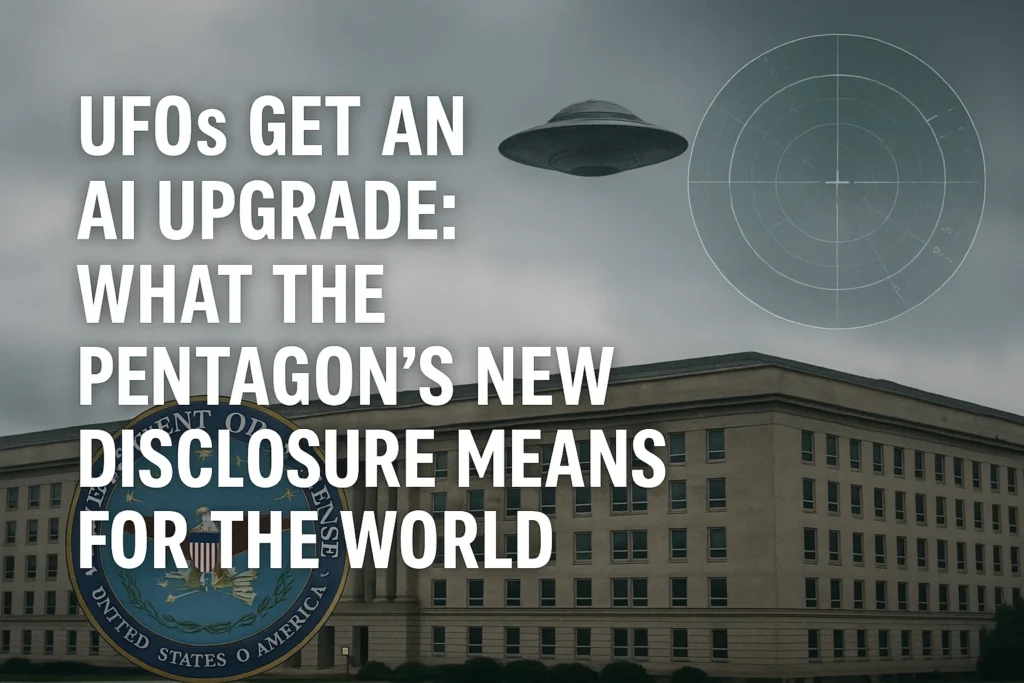For decades, tales of unidentified flying objects, or UFOs, existed in the shadows, fueled by grainy videos, hushed whispers, and the occasional retired pilot’s startling account. The topic was often relegated to the realm of science fiction, met with skepticism and even ridicule. But in recent years, a significant shift has occurred within official circles, most notably within the U.S. Department of Defense. No longer dismissed outright, these “unexplained aerial phenomena,” or UAPs as they are now formally known, are subject to serious scientific scrutiny. And at the heart of this new, rigorous approach lies a powerful tool: Artificial Intelligence.
This isn’t about confirming alien visitations. Instead, it’s about bringing unprecedented precision and objectivity to a mystery that has long captivated humanity. The Pentagon’s All-Domain Anomaly Resolution Office (AARO), the leading investigative body, along with other scientific endeavors, is increasingly turning to AI systems to sift through vast amounts of data, aiming to identify, analyze, and, where possible, explain these elusive sightings. This integration of advanced technology signals a new era of transparency and scientific inquiry, moving beyond speculation to data-driven understanding.
From Whispers to Data: The Shift in UAP Investigation
For much of the 20th century, official investigations into UFOs, like Project Blue Book, were often characterized by limited data, human observational biases, and a prevailing desire to debunk sightings. Pilots, military personnel, and even civilians who reported strange aerial encounters often faced professional repercussions or public ridicule. This created a climate where critical information was suppressed or dismissed, hindering any genuine understanding of the phenomena.
However, a cultural and governmental shift began in the late 2010s. The declassification of compelling videos showing UAPs exhibiting unusual flight characteristics, combined with persistent efforts from certain lawmakers and former intelligence officials, forced the U.S. government to take the matter seriously. In 2020, the Pentagon formally established the Unidentified Aerial Phenomena Task Force (UAPTF), later replaced by the All-Domain Anomaly Resolution Office (AARO) in 2022.
AARO’s mandate is clear: to collect, analyze, and resolve UAP incidents across all domains – air, sea, space, and land – with a focus on potential threats to national security. This represented a crucial turning point. Suddenly, the focus wasn’t on debunking, but on understanding. The challenge, however, remained immense: how to manage and make sense of hundreds of diverse, often incomplete, reports stretching back decades. This is where the power of Artificial Intelligence became indispensable.
The AI Analyst: Sifting Through the Skies
Imagine trying to find a needle in a haystack, but the haystack is constantly growing, and the “needles” are often fleeting glimpses or sensor anomalies. This is the challenge facing UAP investigators. Traditional human analysis, while vital, simply cannot cope with the sheer volume and complexity of data being collected from military sensors, pilot reports, and even public submissions. This is where AI steps in as a tireless, unbiased analyst.
AI systems, particularly those using machine learning and computer vision, are being employed to:
- Process Vast Datasets: AI can ingest and rapidly analyze enormous quantities of sensor data – radar readings, infrared video, optical imagery, electromagnetic signatures – that would overwhelm human analysts.
- Filter Known Objects: One of AI’s most immediate and impactful uses is to accurately identify and filter out common, explainable phenomena. This includes birds, drones, weather balloons, conventional aircraft, atmospheric conditions, and even Starlink satellites. By learning the patterns and signatures of known objects, AI can quickly discard false positives, allowing human experts to focus on the truly anomalous events.
- Identify Anomalies and Patterns: AI algorithms are exceptional at pattern recognition. They can detect subtle deviations from normal flight behavior or unusual object characteristics that might be missed by the human eye. They can also identify correlations between different data points (e.g., radar spikes aligning with infrared signatures) that strengthen the credibility of a sighting.
- Enhance Data Quality: AI can help flag inconsistencies or gaps in data, prompting investigators to seek additional information or improve future data collection methods. It can even help reconstruct flight paths from partial information.
- Automate Case Management: Beyond analysis, AI-powered systems are being developed to manage the ever-growing caseload of UAP reports, categorizing them by type, severity, and priority, ensuring efficient tracking and resolution of investigations.
This “AI upgrade” means that UAP analysis is becoming less about subjective interpretation and more about objective, data-driven science.
The Pentagon’s Pursuit: AARO and AI Integration
The All-Domain Anomaly Resolution Office (AARO) is at the forefront of the Pentagon’s efforts to systematically approach UAP investigation, and AI is increasingly integral to its operations. AARO has been diligently reviewing hundreds of UAP sightings, dating back as far as 1996, and has publicly released reports summarizing its findings.
While AARO has consistently stated that there is no confirmed evidence of extraterrestrial activity associated with UAPs, its reports acknowledge a significant number of cases that remain “unresolved” due to a lack of sufficient data. This is precisely where AI promises to revolutionize the process.
Recent developments in 2025 highlight AARO’s commitment to leveraging AI:
- Advanced Case Management Systems: AARO is actively seeking custom, secure software platforms powered by AI to track, manage, and analyze confidential UAP reports. This system aims to integrate various existing tools and streamline the process of converting raw data into structured, analyzable information.
- Scientific Rigor: The goal is to move beyond anecdotal evidence. By using AI to analyze multi-sensor data (from military aircraft, naval vessels, and ground-based radar), AARO aims to apply a “rigorous scientific framework” to each UAP sighting. This includes analyzing visual data pixel by pixel and cross-referencing it with other sensor inputs.
- Public Reporting Mechanisms: While classified data remains protected, AARO is also developing public-facing mechanisms, potentially leveraging AI, to allow current and former military personnel and federal employees to submit UAP reports securely, increasing the overall pool of data for analysis.
The Pentagon’s focus is on national security—identifying potential foreign adversarial technologies or understanding unusual phenomena that could pose a threat to U.S. airspace. AI’s ability to quickly discern known threats from truly inexplicable anomalies is therefore a critical asset in this mission.
Beyond the Military: NASA and Academic Partnerships
The U.S. Department of Defense isn’t the only entity embracing AI in the quest to understand UAPs. NASA, the nation’s premier space agency, has also embarked on its own UAP study, explicitly recommending the use of AI and machine learning to analyze data. Academic institutions and independent research projects are also developing their own AI-powered solutions.
- NASA’s Approach: Recognizing the need for a scientific, evidence-based approach, NASA formed an independent study team to recommend how the agency could contribute to UAP research. Their findings strongly advocated for utilizing AI and machine learning to process vast amounts of observational data. The idea is to develop “purpose-built future sensors” with AI capabilities to continuously monitor the sky and identify patterns that elude human detection. NASA aims to distinguish natural or human-made phenomena from truly unexplained objects, and their official stance also confirms no evidence of extraterrestrial origins.
- Academic Innovations: Universities are pioneering new AI methodologies. For instance, an international team of physicists, including researchers from the University at Albany, has developed novel AI-integrated methodologies to aid UAP investigations. Their “Custom Target Analysis Protocol” (C-TAP) software uses machine learning to analyze infrared images pixel-by-pixel, effectively filtering out digital noise and known objects to highlight true anomalies. Projects like Harvard’s Galileo Project also employ advanced computer vision and tracking algorithms to analyze footage and reconstruct flight paths, aiming for smarter machine learning algorithms that can filter false positives and improve real-time anomaly detection.
These collaborations demonstrate a broader scientific consensus forming around the necessity of AI to tackle the UAP mystery. By integrating data from multiple sources – military sensors, academic observatories, and even citizen science initiatives – AI can build a more comprehensive and objective picture of what’s truly happening in our skies.
The Promise of Precision: Redefining “Unidentified”
The true power of AI in UAP analysis lies in its ability to bring unprecedented precision to the identification and classification process. For decades, many UAP sightings remained “unidentified” not because they were extraterrestrial, but because there wasn’t enough high-quality data or sufficiently advanced analytical tools to explain them.
AI is changing that by:
- Minimizing Human Bias: AI algorithms, when properly trained, are immune to the biases, expectations, or emotional responses that can influence human observers. They simply process data based on defined parameters.
- Consistent Analysis: AI can apply the same analytical rigor to every single data point, ensuring consistency across thousands of reports.
- Filtering the Mundane: The vast majority of UAP reports turn out to be easily explainable: weather balloons, drones, private aircraft, or even visual illusions. AI excels at rapidly identifying and categorizing these mundane phenomena, allowing human experts to focus their limited resources on the small percentage of truly anomalous cases.
- Revealing Subtle Details: AI can detect minute changes in velocity, trajectory, or energy signatures that might be invisible to the human eye or even standard sensor readouts, providing crucial clues for identification.
This shift means that when a phenomenon does remain unexplained after AI-driven analysis, it carries significantly more weight. It implies that the object or event truly falls outside the known performance envelope of conventional technologies and natural phenomena, pushing the boundaries of our current understanding.
Implications for National Security and Scientific Discovery
The integration of AI into UAP investigation carries profound implications, not just for the study of unexplained phenomena, but for national security and scientific discovery as a whole:
- Enhanced National Security: The primary driver for the Pentagon’s UAP initiatives is national security. AI’s ability to rapidly distinguish between genuine threats (e.g., advanced adversarial reconnaissance craft) and misidentified objects allows military forces to allocate resources more effectively and respond to credible threats with greater speed and accuracy.
- Increased Air Safety: Unidentified objects in restricted airspace pose a significant safety hazard to both military and civilian aircraft. By better understanding and, where possible, predicting UAP behavior, AI can contribute to safer skies.
- Scientific Breakthroughs: Even if no extraterrestrial origins are confirmed, the rigorous scientific study of UAPs, aided by AI, could lead to unexpected discoveries in atmospheric science, aerodynamics, sensor technology, or even physics. Understanding why certain natural phenomena appear unusual or how human-made objects interact with the environment in unexpected ways can lead to new insights.
- Transparency and Trust: By demonstrating a commitment to data-driven, objective analysis, the Pentagon and other agencies can foster greater public trust and reduce speculation. Transparent methodologies, even if findings remain classified in certain contexts, can help demystify the topic and shift the public conversation.
- Pushing AI Capabilities: The unique challenges of UAP analysis—dealing with sparse, noisy, and varied data—push the boundaries of AI research, leading to advancements in areas like anomaly detection, real-time processing, and multi-modal sensor fusion.
The use of AI is transforming the UAP narrative from one of sensationalism to one of systematic scientific inquiry, with tangible benefits for both security and knowledge.
The Road Ahead: Continuous Learning and Collaboration
The journey of understanding UAPs through the lens of AI is still in its early stages. The road ahead involves continuous learning, technological refinement, and deeper collaboration.
- Improved Data Collection: Future efforts will focus on deploying more advanced, multi-sensor systems specifically designed to capture high-quality UAP data. This includes sophisticated infrared cameras, advanced radar, and other instrumentation that can provide more complete information for AI analysis.
- Refining AI Models: AI models are constantly evolving. As more data is fed into these systems, they will become even more adept at distinguishing known objects from truly anomalous ones. This involves training algorithms on diverse datasets and refining their ability to learn from new, ambiguous cases.
- Interagency and International Collaboration: Sharing data and analytical methodologies between government agencies (like the DoD and NASA) and international partners will be crucial. Collaborative efforts can pool resources, reduce duplication of effort, and accelerate understanding.
- Public Engagement: Maintaining a level of transparency, while balancing national security concerns, will be important for sustained public interest and cooperation, including potential citizen science initiatives where AI could help process crowdsourced data.
The Pentagon’s embrace of AI for UAP analysis is more than just a technological upgrade; it’s a profound shift in how we approach one of the most enduring mysteries. By applying the sharp, objective logic of artificial intelligence to the vastness of our skies, we are taking significant strides toward understanding what truly lies beyond our immediate comprehension, promising a future where less and less remains “unidentified.”



